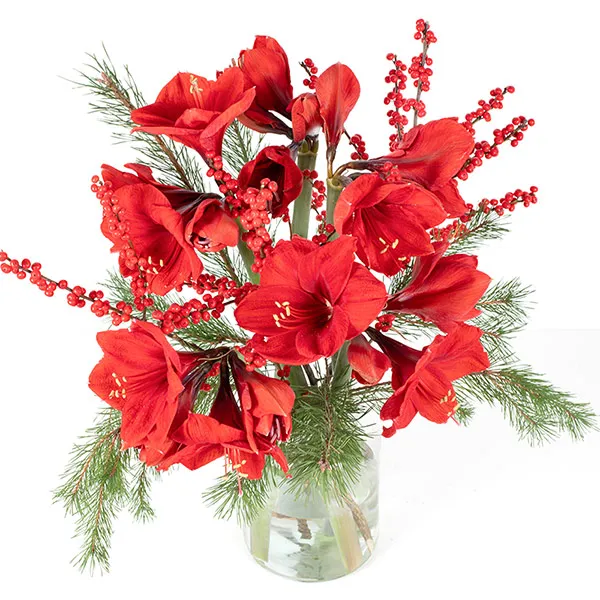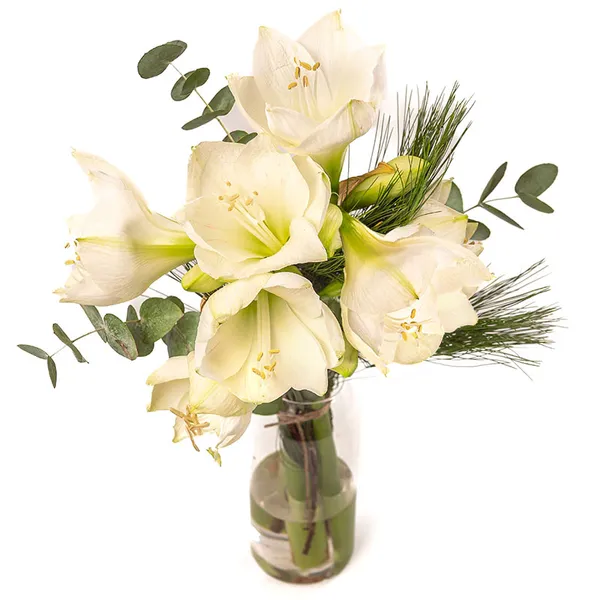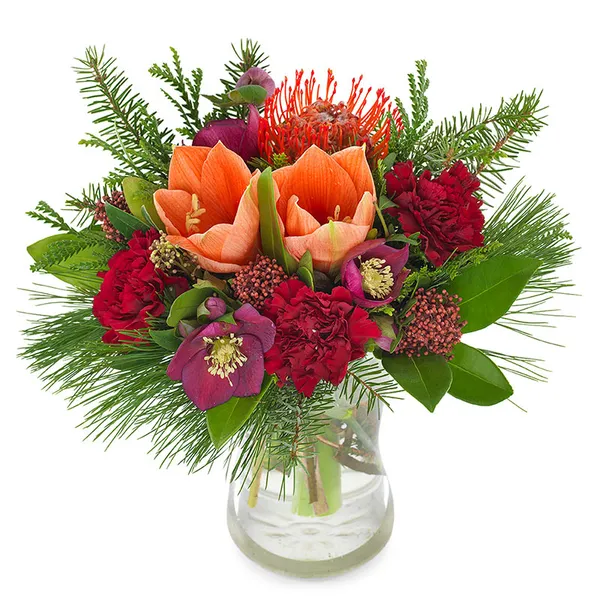Amaryllis
Amaryllis is a popular flower known for its large, trumpet-shaped blooms in vibrant colours like red, white, and pink. While these are the three colours that are most commonly available in flower shops, there are around 100 different varieties of amaryllis in total. Native to South America, the amaryllis is a favourite for Christmas decorations. Symbolising pride, determination, and beauty, its name comes from the Greek "amarysso," meaning "to sparkle." Amaryllis represents beauty, love, and strength, making it perfect for festive occasions and uplifting spirits.
COMMON NAME
Amaryllis
BOTANICAL NAME
Hippeastrum
ORIGIN
Native to South America (Andes)
PEOPLE ALSO CALL IT
Belladonna lily, naked lady
FLOWERING TIME
Winter (blooms in late fall to winter)
ASPECT
Full sun to partial shade
SYMBOLISM
Pride, beauty, determination, love
General Care Tips for Cut Amaryllis in Vase
Watering: Keep the vase clean and filled with fresh water til halfway up the stem, changing it every 2-3 days.
Trimming: Cut stems at a diagonal every few days to improve water absorption.
Vase Choice: Choose a tall, sturdy vase, as amaryllis flowers have heavy, top-heavy blooms.
Temperature: Keep the flowers in a cool room away from direct sunlight and drafts, which can shorten the lifespan.
Support: As the stems grow and bend, you can support them with stakes or floral wire.
Flower Food: Add flower food to the water to help extend the bloom period.
Symbolism & Meaning
Amaryllis symbolises pride, strength, and determination, reflecting its ability to bloom even in the harshest conditions. The flower is also associated with beauty and love, often used to convey admiration or to celebrate festive occasions. In mythology, amaryllis represents a dramatic and enchanting beauty that captivates and enchants those who behold it, making it a popular choice for expressing affection and appreciation.
Amaryllis watering hacks
Amaryllis is a delicate flower that struggles to absorb water because of its long, air-filled stem. By poking a hole in the stem at the top of the flower, you let the air escape so it can absorb more water. Next, put your amaryllis in a bucket of water for a few hours so it can absorb a lot of water before you put it in a vase. Sometimes you may even hear a whistling sound, which means the air is leaving the stem. To put the amaryllis in a nice vase, hold your finger over the opening in the stem to keep the water in.
Many amaryllises are sold with a stick in the stem to support them. Be careful that the stick does not damage your amaryllis from the inside or rot in the water. If you want to avoid rotting sticks, choose a tall and narrow vase to put the stems in. With proper care, your amaryllis will last about two weeks. Make sure you occasionally remove a wilted leaf or flower, otherwise they will take energy away from the other flowers.
Frequently Asked Questions About Amaryllis
Our flower expert Lisa van Marrewijk, amaryllis grower with 30 years of experience, advices on cutting back amaryllis leaves:
When placing the bulb in cold storage, you can do so with the leaves still attached. During the cooling phase, the leaves will die back and turn brown. Once you bring the bulb back indoors, you should remove the brown leaves. However, do not cut back the green leaves if you want the bulb to bloom again.
Planting the Bulb: Use a well-draining pot with a good quality potting mix. Position the bulb so that the top third remains above the soil.
Watering: Water sparingly until growth appears, then water more frequently, keeping the soil moist but not soggy.
Light and Temperature: Place the amaryllis in a warm, sunny spot with indirect light. A temperature range of 20-25°C is ideal.
Fertilising: Feed the plant every two weeks during the growth period with a balanced fertiliser to support the development of leaves and flowers.
Staking: As the flower stalk grows, it may need staking for support.
Reblooming: After blooming, follow the post-bloom care steps above to ensure the bulb regains its energy for the next season.
Our flower expert Lisa van Marrewijk, amaryllis grower with 30 years of experience, advices on how to care for your amaryllis bulb:
Treat the bulb like a houseplant. Make sure the soil doesn’t get too wet, as this is the biggest risk for things to go wrong. Water sparingly until growth appears, then water more frequently, keeping the soil moist but not soggy. Place the amaryllis in a warm, sunny spot with indirect light. A temperature range of 20-25°C is ideal. Turn the pot regularly so that the stems don't grow crooked. As the flower stalk grows, it may need staking for support.
According to our flower expert Lisa van Marrewijk, amaryllis grower with 30 years of experience, it depends on the room temperature. According to her, with good conditions, yu can enjoy the flower for about two weeks.
Trim the stems when they start to 'curl'. You can also put a rubber band or clear tape around the end of the stem. This keeps them from splitting and rolling up so easily, because if that happens, your amaryllis won't be able to absorb water as easily.
Our flower expert Lisa van Marrewijk, amaryllis grower with 30 years of experience, advices on how to take care of your amaryllis after it blooms:
When your amaryllis has finished blooming, remove the flower stalk. It’s important for the leaves to grow now, as they produce the nutrients needed for a new stalk next year. (Note: This process won’t work with a waxed bulb.) Care for the plant as well as you can by providing fresh soil, enough water, and plenty of light until about June/July.
In summer, the bulbs can also be placed outdoors, as long as the temperature stays above 15°C. In August, place the bulb in a cool spot at around 12°C for two months. During this time, the leaves will die back, and the bulb will form a new flower inside. A dry and cool place, like a basement, is ideal. During these two months, you don’t need to do anything else.
After two months, take the bulb out of the cool space and place it in a warm spot (around 20°C). If you’ve cared for the bulb properly, it will produce a new flower stalk. With excellent care, it might even grow two or three flower stalks.
The motto is: prevention is better than cure. You want to avoid pollen stains on clothes or on a petal. This is because if pollen gets on a petal, it will be damaged and wilt faster. And a pollen stain on your clothes is difficult to remove. So cut away the stamens as soon as possible.
In the unlikely event that a stain does develop on your clothes, don't panic! The best thing you can do is remove the stain by blowing, using a dry brush, letting the stain dry in the sun or going over the pollen with an adhesive tape. Avoid using a wet cloth as this will actually get the pollen deeper into the fabric.
Amaryllis and Hippeastrum are two different plants, even though they are frequently sold under the single name “amaryllis.” Why? At Euroflorist, we use the name amaryllis to describe plants that botanists typically classify as Hippeastrum, in line with the botanical distinction between the two. You can tell them apart mainly by the stem: a Hippeastrum stem is hollow, thick, and sturdy, while a "true" Amaryllis stem is solid inside. Hippeastrum flowers are also much larger. The large bulb plants commonly grown in pots and blooming around Christmas almost always belong to the Hippeastrum genus. However, the name amaryllis has become so widespread in everyday language — even among growers — that we use it at Euroflorist for clarity and customer convenience. It’s the name people recognise and understand, regardless of the strict botanical classification.




